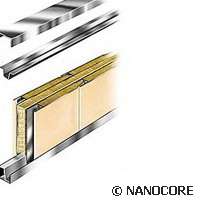Making safer composite materials for ship building

Just like any mode of transport that carries members of the public, ships are subject to strict safety regulations. These not only cover the use and maintenance of the vessel but also its construction and the materials a ship is made of.
Until a few years ago, the Registration, Evaluation and Authorisation of Chemicals (REACH) legislation, a European Union regulation which addresses the production and use of chemical substances, stated that composite materials could not be used in the construction of commercial ferries and cruise ships due to safety fears.
REACH, as part of the International Convention for the Safety of Life at Sea (SOLAS), dictated that ship components such as superstructures, bulkheads, decks and deckhouses must be made from steel or an equivalent material. Composite materials, especially those containing foam and plastics, were considered a risk as they can be combustible and could release toxic fumes in the event of fire.
However, in 2002, a new rule in SOLAS allowed the use of materials other than steel to be used in ship building as technological advances had brought many composite materials up to the same safety levels as steel in terms of non-combustibility. With this and other legislative amendments, ship builders then began to experiment with new lightweight materials while still adhering to the strict safety rules covering the construction of passenger-carrying vessels.
The development of increasingly lighter ship building materials continues to this day, while new flame retardant standards within SOLAS mean that this research also includes ensuring a higher level of fire safety.
The EU-funded NANOCORE Project has been developing a new and cost-effective production technology for sandwich structures - polymeric foam core materials with non-toxic flame retardants and enhanced mechanical properties - which will meet these new standards.
Most current flame retardant (FR) additive systems used in polymeric foams are not able to meet the new SOLAS standards. So foam core materials for sandwich construction, used to produce lightweight and stiff structures, require a new generation of FR additive systems to reduce smoke toxicity and bestow fire resistance properties.
NANOCORE is developing a new FR System based on a combination of nanoparticles modified with a phosphorous flame retardant.
The technology developed during the project will be directly and easily transferable to other polymer-based materials, such as bulk thermoplastics, thermosets, composites and other foams - enabling them to meet the new requirements set out in SOLAS.
In fact, the use of this technology is not expected to be restricted to the shipbuilding industry. The project team anticipate that all applications of plastic materials requiring FST (fire science technology) properties can be met by the NANOCORE system.
More information: NANOCORE PROJECT www.nanocore-project.eu/
Provided by CORDIS


















